Something Out of Nothing ~ Ciabatta Tuna Sandwich
It has been a while since I have the desire to take my first shot in participating in one of IMBB events. A while ago, it was fun looking at people's creation and especially admiring the nicely assembled pictures. A while ago, I was not encouraged enough to take part, mostly because I only found out about the event right after the round-up. A while ago, not too long back, I checked the schedule over at IMBB and got my eyes caught at this one-time event. That while ago is now. And now is time to finally share my creation in an IMBB event :)
This so-called "Something Out of Nothing" is a one-time event hosted by Lindy from Toast. This has caught my attention, because I'm probably one of the people that would rather prepare low-cost yet tast dishes for daily comsumption. I am a STUDENT!
So, ever since I've heard about this event (which was not even a week ago) I have been thinking of what taste-bud enticing meals I could prepare from anything that is sitting inside my fridge right now. I turned my head around. Thinking about my easy-to-prep Lemon Garlic Brussel Sprouts, then comforting Pancetta Omelette, and recently a very simple dish calling only 5 ingredients called Stir-Fried Green Beans with Ground Beef.
Nonetheless, I have this leading candidate, that I have made before I was aware of this event. Guess no more, it's a Ciabatta Tuna Sandwich with Homemade Ciabatta Bread :)
I just thought this would be suitable because I literally created the Ciabatta bread from scratch, consisting only bread flour, instant yeast, water, and salt. Baking an artisan bread is again very rewarding, but to note, the process is quite laborious. The process took me up to two days including making the pre-ferment. The day after the pre-ferment was made, the real process of making Ciabatta begun. It took me around 7-8 hours after the pre-ferment was ready.
So, I admit it was time-consuming. But, you can still do it in between your normal activity. Trust me, they are quite low-maintenance :)
The recipe for Ciabatta was followed accordingly with Peter Reinhart's renowned "The Bread Baker's Apprentice".
The Ciabatta itself should be nicely complimented with plain cream cheese, nutella, or even toasted in margarine. However, I felt like jazzing it up a little bit, so I notoriously assembled my creation of tuna spread :) I took out whatever I could find in my fridge, and ta-da! A delicious fresh tangy and salty tuna sandwich. The two Ciabatta slices absorbed all of the flavors very well, making it even more delicious.
Shall get on to the recipe? I've dragged you long enough, haven't I?
Ciabatta (Biga Version)
Biga
2-1/2 cups unbleached bread flour
1/2 tsp instant yeast
4/3 cup plus 2 T to 1 cup water, at room temperature
01. Stir together the flour and yeast in a 4-quart bowl. Add the 3/4 cup plus 2 T of water, stirring until everything comes together an makes a coarse ball. Adjust the flour or water, according to need, so that the dough is neither too sticky nor too stiff.
02. Sprinkle some flour on the counter and transfer the dough to the counter. Knead for 4 to 6 minutes, or until the dough is soft and pliable, tacky but not sticky.
03. Lightly oil a bowl and transfer the dough to the bowl, rolling it around to coat with oil. Cover the bowl with plastic wrap and ferment at room temperature for 2 to 4 hours, or until it nearly doubles in size.
04. Remove the dough from the bowl, knead it lightly to degas, and return it to the bowl, covering the bowl with plactic wrap. Place the bowl in the fridge overnight to bring out more flavors. This can be kept in the fridge for up to 3 days, or freeze in an airtight plastic bag for up to 3 months.
Ciabatta
3 cups biga
2 cups unbleached bread flour
1-1/2 tsp salt
1-1/2 tsp instant yeast
3/4 cup plus 2 T to 1-1/8 cups water, lukewarm
1/4 cup olive oil (optional)
01. Remove the biga from the refrigerator 1 hour before making the dough. Cut it into 10 small peices with a serrated knife. Cover with a towel or plastic wrap and let sit for 1 hour.
02. To make the dough, stir together the flour, salt, and yeast in a 4-quart mixing bowl. Add the biga pieces and 3/4 cup plus 2 T water and the oil. With a large spoon, mix until the ingredients form a sticky ball. If there is still some loose flour, add the additional water as needed and continue to mix.
03. With your hands, repeatedly dip one of your hands or the spoon into cold water and use it, much like a dough hook, to work the dough vigorously into a smooth mass while rotating the bowl in a circular motion with the other hand. Reverse the circular motion a few times to develop the gluten further. Do this for 5 to 7 minutes, or until the dough is smooth and the ingredients are evenly distributed.
04. Sprinkle enough flour on the counter to make a bed about 8 inches square. Using a bowl scraper, transfer the sticky dough to the bed of flour and proceed with the stretch-and-fold method shown below.
"Stretch-and-fold Method" ~ this is the fun part!
A) Dust the top of the dough liberally with flour, patting the dough into a rectangle. Wait 2 minutes for the dough to relax. Coat your hands with flour.
B) Lift the dough from each end, stretching it to twice its size.
C) Fold the dough over itself, letter style, to return it to a rectangular shape.
04. cont'd - Mist top of the dough with spray oil (I rubbed regular oil with my hands), again dust with flour, and loosely cover with plastic wrap.
05. Let rest for 30 minutes. Stretch and fold the dough again; mist with spray oil, dust with flour, and cover. Allow the covered dough to ferment on the counter for 1-1/2 to 2 hours. It should swell but not necessarily double in size.
06. Set up a long tea towel on your conter. Carefully remove the plastic from the dough. Divide the dough into 2 or 3 rectangles with a pastry scrapper carefully not to degas the dough. Sprinkle the dough generously with more flour and, using the scraper to get under the dough, gently lift each piece from the counter then roll it on both sides in the loose flour to coat. Lay the loaves on the tea towl and gently fold each piece of dough, from left to right, letter style, into an oblong about 6 inches long. Bunch the towel between the pieces to provide a wall. Mist the dough with oil and dust the dough with more flour, then cover with another tea towel.
07. Proof for 45 to 60 minutes at room temperature, or until the dough has noticeably swelled.
08. Prepare the oven by placing an empty steam pan before turning the oven on. Preheat to 500 degrees F.
09. Line your baking sheet with parchment paper. Carefully transfer your dough onto the baking sheet and slide it into the oven. Pour 1 cup of hot water into the steam pan and close the door. After 30 seconds, open the door, spray the side walls of the oven with water, and close the door. Repeat twice more at 30-seconds intervals. After the final spray, turn the oven setting down to 450 degrees F and bake for 10 minutes. Rotate the loaves 180 degrees for even baking, and continue baking for 5 to 10 minutes longer or until evenly golden brown. The loaves will feel quite hard and crusty at first but will soften as they cool
10. Transfer the bread from the oven to a cooling rack and allow to cool for at least 45 minutes before slicing or eating.
Phew, that was a long recipe to type :p
Now for the tuna filling, you will need:
1/2 of small can of tuna in olive oil
2 strips of anchovies, shredded, microwaved (to soften the bones)
1/4 of green bell pepper, diced
2 to 3 T plain mayonaisse (I used Japanese QP "KewPee" mayo)
1 to 2 tsp freshly squeezed lemon juice
freshly ground black pepper
salt
Combine all ingredients in one bowl, then spread them liberally in between two slices of fresh Ciabatta bread. Adjust according to your taste.
Wrap it in plastic wrap for lunch at school :)
To make this lenghty process like a zap, buy a fresh Ciabatta bread from your local grocery! Simple as that ;)
As usual, after baking an artisan bread, I usually learnt or observed something. This, time I need to warn myself not to bake in very high heat (500F) with cornmeal dusted on the baking sheet. The result is, burnt-bottomed bread!!
Also, I have to share with you that the Ciabatta didn't turn out as well as it should be, mainly because I didn't follow the instruction carefully. Here the instruction is clear (and long, I know) and it should be alright when you try to make it :)
Mine doesn't have the airy holes I longed for, next time it will be better. Practice in artican baking is a cruicial factor anyway :)
This so-called "Something Out of Nothing" is a one-time event hosted by Lindy from Toast. This has caught my attention, because I'm probably one of the people that would rather prepare low-cost yet tast dishes for daily comsumption. I am a STUDENT!
So, ever since I've heard about this event (which was not even a week ago) I have been thinking of what taste-bud enticing meals I could prepare from anything that is sitting inside my fridge right now. I turned my head around. Thinking about my easy-to-prep Lemon Garlic Brussel Sprouts, then comforting Pancetta Omelette, and recently a very simple dish calling only 5 ingredients called Stir-Fried Green Beans with Ground Beef.
Nonetheless, I have this leading candidate, that I have made before I was aware of this event. Guess no more, it's a Ciabatta Tuna Sandwich with Homemade Ciabatta Bread :)
I just thought this would be suitable because I literally created the Ciabatta bread from scratch, consisting only bread flour, instant yeast, water, and salt. Baking an artisan bread is again very rewarding, but to note, the process is quite laborious. The process took me up to two days including making the pre-ferment. The day after the pre-ferment was made, the real process of making Ciabatta begun. It took me around 7-8 hours after the pre-ferment was ready.
So, I admit it was time-consuming. But, you can still do it in between your normal activity. Trust me, they are quite low-maintenance :)
The recipe for Ciabatta was followed accordingly with Peter Reinhart's renowned "The Bread Baker's Apprentice".
The Ciabatta itself should be nicely complimented with plain cream cheese, nutella, or even toasted in margarine. However, I felt like jazzing it up a little bit, so I notoriously assembled my creation of tuna spread :) I took out whatever I could find in my fridge, and ta-da! A delicious fresh tangy and salty tuna sandwich. The two Ciabatta slices absorbed all of the flavors very well, making it even more delicious.
Shall get on to the recipe? I've dragged you long enough, haven't I?
Ciabatta (Biga Version)
Biga
2-1/2 cups unbleached bread flour
1/2 tsp instant yeast
4/3 cup plus 2 T to 1 cup water, at room temperature
01. Stir together the flour and yeast in a 4-quart bowl. Add the 3/4 cup plus 2 T of water, stirring until everything comes together an makes a coarse ball. Adjust the flour or water, according to need, so that the dough is neither too sticky nor too stiff.
02. Sprinkle some flour on the counter and transfer the dough to the counter. Knead for 4 to 6 minutes, or until the dough is soft and pliable, tacky but not sticky.
03. Lightly oil a bowl and transfer the dough to the bowl, rolling it around to coat with oil. Cover the bowl with plastic wrap and ferment at room temperature for 2 to 4 hours, or until it nearly doubles in size.
04. Remove the dough from the bowl, knead it lightly to degas, and return it to the bowl, covering the bowl with plactic wrap. Place the bowl in the fridge overnight to bring out more flavors. This can be kept in the fridge for up to 3 days, or freeze in an airtight plastic bag for up to 3 months.
Ciabatta
3 cups biga
2 cups unbleached bread flour
1-1/2 tsp salt
1-1/2 tsp instant yeast
3/4 cup plus 2 T to 1-1/8 cups water, lukewarm
1/4 cup olive oil (optional)
01. Remove the biga from the refrigerator 1 hour before making the dough. Cut it into 10 small peices with a serrated knife. Cover with a towel or plastic wrap and let sit for 1 hour.
Smooth-textured biga :)
02. To make the dough, stir together the flour, salt, and yeast in a 4-quart mixing bowl. Add the biga pieces and 3/4 cup plus 2 T water and the oil. With a large spoon, mix until the ingredients form a sticky ball. If there is still some loose flour, add the additional water as needed and continue to mix.
03. With your hands, repeatedly dip one of your hands or the spoon into cold water and use it, much like a dough hook, to work the dough vigorously into a smooth mass while rotating the bowl in a circular motion with the other hand. Reverse the circular motion a few times to develop the gluten further. Do this for 5 to 7 minutes, or until the dough is smooth and the ingredients are evenly distributed.
04. Sprinkle enough flour on the counter to make a bed about 8 inches square. Using a bowl scraper, transfer the sticky dough to the bed of flour and proceed with the stretch-and-fold method shown below.
"Stretch-and-fold Method" ~ this is the fun part!
A) Dust the top of the dough liberally with flour, patting the dough into a rectangle. Wait 2 minutes for the dough to relax. Coat your hands with flour.
B) Lift the dough from each end, stretching it to twice its size.
C) Fold the dough over itself, letter style, to return it to a rectangular shape.
04. cont'd - Mist top of the dough with spray oil (I rubbed regular oil with my hands), again dust with flour, and loosely cover with plastic wrap.
05. Let rest for 30 minutes. Stretch and fold the dough again; mist with spray oil, dust with flour, and cover. Allow the covered dough to ferment on the counter for 1-1/2 to 2 hours. It should swell but not necessarily double in size.
06. Set up a long tea towel on your conter. Carefully remove the plastic from the dough. Divide the dough into 2 or 3 rectangles with a pastry scrapper carefully not to degas the dough. Sprinkle the dough generously with more flour and, using the scraper to get under the dough, gently lift each piece from the counter then roll it on both sides in the loose flour to coat. Lay the loaves on the tea towl and gently fold each piece of dough, from left to right, letter style, into an oblong about 6 inches long. Bunch the towel between the pieces to provide a wall. Mist the dough with oil and dust the dough with more flour, then cover with another tea towel.
07. Proof for 45 to 60 minutes at room temperature, or until the dough has noticeably swelled.
08. Prepare the oven by placing an empty steam pan before turning the oven on. Preheat to 500 degrees F.
09. Line your baking sheet with parchment paper. Carefully transfer your dough onto the baking sheet and slide it into the oven. Pour 1 cup of hot water into the steam pan and close the door. After 30 seconds, open the door, spray the side walls of the oven with water, and close the door. Repeat twice more at 30-seconds intervals. After the final spray, turn the oven setting down to 450 degrees F and bake for 10 minutes. Rotate the loaves 180 degrees for even baking, and continue baking for 5 to 10 minutes longer or until evenly golden brown. The loaves will feel quite hard and crusty at first but will soften as they cool
10. Transfer the bread from the oven to a cooling rack and allow to cool for at least 45 minutes before slicing or eating.
Phew, that was a long recipe to type :p
Now for the tuna filling, you will need:
1/2 of small can of tuna in olive oil
2 strips of anchovies, shredded, microwaved (to soften the bones)
1/4 of green bell pepper, diced
2 to 3 T plain mayonaisse (I used Japanese QP "KewPee" mayo)
1 to 2 tsp freshly squeezed lemon juice
freshly ground black pepper
salt
Combine all ingredients in one bowl, then spread them liberally in between two slices of fresh Ciabatta bread. Adjust according to your taste.
Wrap it in plastic wrap for lunch at school :)
To make this lenghty process like a zap, buy a fresh Ciabatta bread from your local grocery! Simple as that ;)
As usual, after baking an artisan bread, I usually learnt or observed something. This, time I need to warn myself not to bake in very high heat (500F) with cornmeal dusted on the baking sheet. The result is, burnt-bottomed bread!!
Also, I have to share with you that the Ciabatta didn't turn out as well as it should be, mainly because I didn't follow the instruction carefully. Here the instruction is clear (and long, I know) and it should be alright when you try to make it :)
Mine doesn't have the airy holes I longed for, next time it will be better. Practice in artican baking is a cruicial factor anyway :)




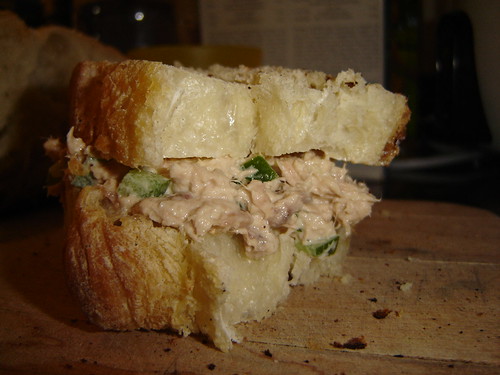
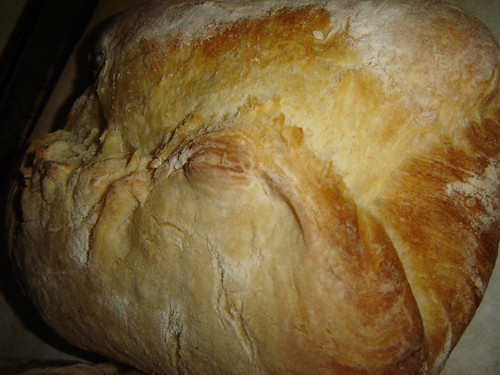
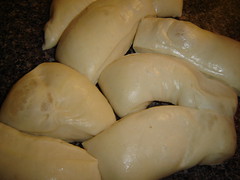
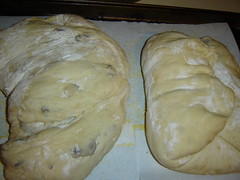
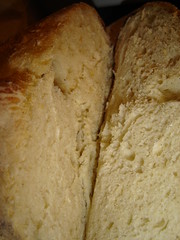
4 Comments:
I've got to try this ciabatta!
I'm working on sourdough breaad today, but it seems a lot less complicated than what you're doing.
Michel - In contrast, sourdough seems more complicated. But, I'll have no say yet since I haven't tried making it :) I should, shouldn't I?
I hope you'll share your sourdough bread in you blog one of these days :)
No worries. I should be posting it tomorrow (Wednesday).
I love the "Ciabatta" post, and all the rest, Thank you :-)
Post a Comment
<< Home